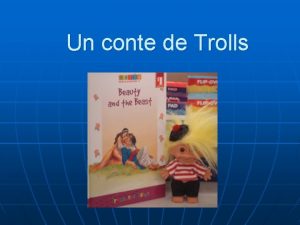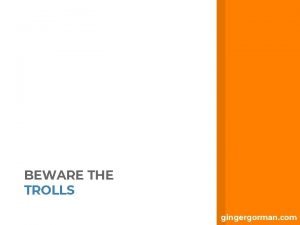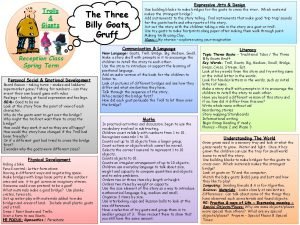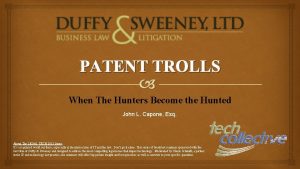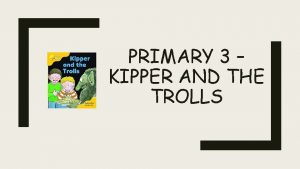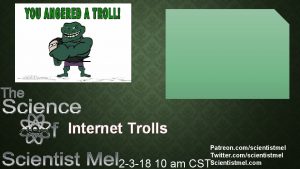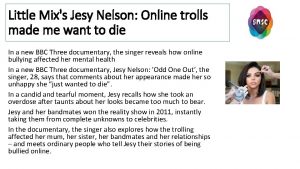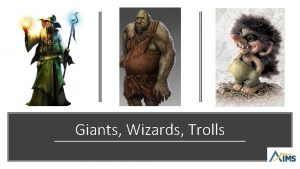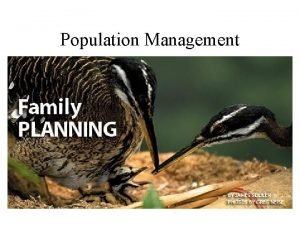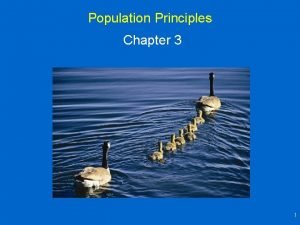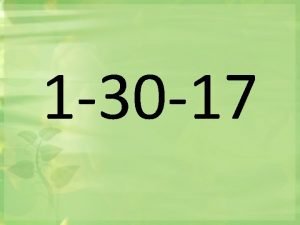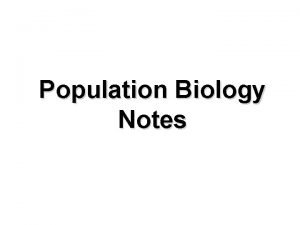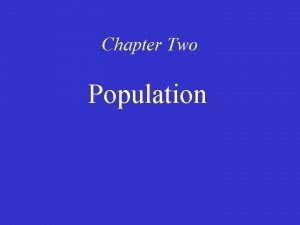DO NOW In a population of trolls the




























- Slides: 28

DO NOW In a population of trolls the trait for snaggle toes (T) is dominant and the trait for straight toes is recessive (t). Also, the trait for blue hair is dominant (B) and the trait for green hair is recessive. Two heterozygous trolls (for both traits) get married. What is the probability their offspring look like them? Draw the Punnett squares and write out the phenotypic ratios.


Review from Worksheet • In a sheep, assume that spotted skin (S) is dominant over non-spotted skin (s) and that wooly hair (W) is dominant over non-wooly hair (w). Cross a marriage between a heterozygous spotted, non-wooly sheep with a wooly-haired, non-spotted sheep. Give the phenotypic ratio of the offspring.

Today’s Lesson • Objective: I can explain the function of polygenic, incomplete dominance, and codominance in inheritance. • Essential Question: What happens when inheritance patterns go beyond Mendel’s Law of Dominance?

Notes

Review Mendel • Two types of alleles? • Dominant and recessive • Each gene requires 2 alleles • Three allele combinations? • Homozygous Dominant (HH) • Heterozygous (Hh) • Homozygous recessive (hh) • Three Mendel's laws of inheritance • Law of Dominance • Law of Segregation • Law of Independent Assortment

Mendel Review Monohybrid cross Dihybrid cross • Mono = one • Examine inheritance of one trait • Punnett square with 4 grid boxes • Grid boxes have 2 alleles (1 trait) • Di = two • Examine inheritance of two traits • Punnett square with 16 grid boxes • Grid boxes contain 4 alleles (2 traits)

Non-Mendelian Genetics There a few types in inheritance patters that go beyond what Mendel discovered: • Incomplete Dominance • Codominance • Polygenetic

Incomplete Dominance • Genotype = heterozygous • Neither allele has complete dominance over the other, which results in a third phenotype. • Heterozygous phenotype = mix/blend of the two parent alleles RR Homozygous dominant RED rr Homozygous recessive WHITE Rr Heterozygous PINK

Incomplete Dominance • Using Mendel's laws of Your segregation and independent turn W assortment, cross a Red flower (RR) with a white flower (WW) • What are the possible genotypes R RW and phenotypes of the offspring? • Geno: 4 heterozygous RW • Pheno: 4 pink flowers R RW W RW RW

Incomplete Dominance • Using Mendel's laws of Your segregation and independent turn R assortment, two pink flowers RW • What are the possible genotypes and phenotypes of the offspring? R RR • Geno: 1 RR: 2 RW: 1 WW • Pheno: 1 Red, 2 Pink and 1 White W RW WW

Codominance • Co = together • Heterozygous genotype • Neither allele is dominant nor recessive • Phenotype- Both alleles fully and separately expressed (visible) Erminette

Codominance • A red colored flower (RR) is crossed with a white colored flower (WW). Your • Use Mendel's laws of segregation and turn independent assortment to complete the Punnett square. W • What are the possible genotypes and RW R phenotypes of the offspring? • Genotype: 4 heterozygotes (RW) • Phenotype: 4 red and white flowers R RW W RW RW

Polygenic Inheritance What do you think poly- means? What do you think –genic means? Polygenic inheritance is expressed when multiple genes each make a small contribution to the overall phenotype. • Allows for more than 2 or 3 variations in expressed phenotypes • For example, skin color ranges from very fair to very dark skin shades. • At least 378 genes are involved in determining skin color.

Polygenic Inheritance • Punnett squares are complicated for polygenic inheritance. • Other factors are involved with polygenic traits. • What else can influence skin color? • Environment & nutrition • Other polygenic traits: • Height, eye color, hair color and body shape

Polygenic Inheritance • Which person in the picture above received more dominant alleles for pigment? • Which received more recessive alleles for pigment? • Which traits do you think are more prominent? • Describe the possible genotypes for the man on the right.

Lab Stations • We will complete two activities to simulate the inheritance patterns we discussed today. • Don’t Lose your Marbles – Codominance & Incomplete Dominance • Eye Color – Polygenic Inheritance • The class will be split in half • Each doing a different lab • 20 minutes at each lab • You will have directions at each station. • Read and follow the directions completely.

Don’t Lose Your Marbles Materials: • 1 Cup with blue beads – labeled #1 • 1 Cup with yellow beads – labeled #2 • 1 Empty clear cup – labeled #3 • 1 Cup of blue dye – labeled #4 • 1 Cup of yellow dye - labeled #5 • 1 Empty clear cup – labeled #6 Simulation 1: Cups #1 - #3 Beads Simulation 2: Cups #4 - #6 Dye Clean up: • Separate beads back into their original cups • Pour out & rinse cup #6 (back sinks) • Refill cup #4 with blue dye up to the line • Refill cup #5 with yellow dye up to the line • Wipe up your desk if needed. Allele Genotype(s) Phenotype Cup 1 Cup 2 Cup 3 Allele Cup 4 Cup 5 Cup 6

Eye Color & Polygenic Inheritance Materials: Bag labeled “Female” with 6 Blue chips and 6 yellow chips Bag labeled “Male” with 6 blue chips and 6 yellow chips Dropper bottle with blue dye Dropper bottle with yellow dye Bag Labeled “Mother” Bag Labeled “Father” Well plate White Paper Part 1: Spectrum Answer questions 1 & 2 on the back of your student sheet Part 2: Determining the parent’s eye color Part 3: Determining the offspring's eye color Answer questions 3 & 4 on the back of your student sheet Clean up: • Empty & rinse well plate • Empty all chips from “Mother” & “Father” bags • Make sure there are 6 blue and 6 yellow chips in the “Male” bag • Make sure there are 6 blue and 6 yellow chips in the “Female” bag • Place all materials in the basket

Lab Stations – Expectations • Questions – ask three before me • Stay at your desk area • Low voice levels When you are done. . • Clean up your station according to the directions in your basket. • Complete lab analysis questions or practice problems. • Complete vocabulary (old or new) • Work on any late/missing work.

Don’t Lose Your Marbles Materials: • 1 Cup with blue beads – labeled #1 • 1 Cup with yellow beads – labeled #2 • 1 Empty clear cup – labeled #3 • 1 Cup of blue dye – labeled #4 • 1 Cup of yellow dye - labeled #5 • 1 Empty clear cup – labeled #6 Which simulation is codominance? How do you know? Which simulation is incomplete dominance? How do you know? Allele Genotype(s) Phenotype Cup 1 Cup 2 Cup 3 Allele Cup 4 Cup 5 Cup 6

Eye Color & Polygenic Inheritance Materials: Bag labeled “Female” with 6 Blue chips and 6 yellow chips Bag labeled “Male” with 6 blue chips and 6 yellow chips Dropper bottle with blue dye Dropper bottle with yellow dye Part 1: Spectrum Bag Labeled “Mother” Bag Labeled “Father” Well plate White Paper • Describe the spectrum • How does the dominant allele impact the phenotype? Part 2: Determining the parent’s eye color Part 3: Determining the offspring's eye color • How did the phenotype of your offspring compare to the parents? • Compare the results from this lab to real life.

Let’s Practice 4. In fish of the species Perissodus microlepis, some individuals have mouths that open to the right and some individuals have mouths that open to the left. The direction of the mouth opening is a genetic trait controlled by a single gene. The allele for a right-opening mouth (R) is dominant to the allele for a left-opening mouth (r). If two fish heterozygous for the mouth trait are crossed, what is the expected ratio of phenotypes in the offspring? A. 1 right-opening mouth : 3 left-opening mouth B. 2 right-opening mouth : 2 left-opening mouth C. 3 right-opening mouth: 1 left-opening mouth D. 4 right-opening mouth: 0 left-opening mouth

What about our genes? Closing • Explain how • Identify and • Explain how phenotype is explain how phenotype is affected by Mendel's affected by codominance. Laws play a polygenic incomplete role in Nontraits. dominance. Mendelian inheritance.

Exit Ticket Clear your desk

1. Hitchhiker's thumb (H) is dominant to no hitchhiker's thumb (h). A woman who does not have hitchhiker's thumb marries a man who is heterozygous for hitchhiker's thumb. What is the probable genotypic ratio of their children? A. 0% Hh: 100% hh B. 50% Hh: 50% hh C. 75% Hh: 25% hh D. 100% Hh: 0% hh

2. Not all traits follow the Mendelian inheritance patterns. Some traits are determined by the combined effect of more than one pair of genes. Height is controlled by at least three genes with six alleles. If you are dominant for all of the alleles for height, then you will be very tall. There is also a wide range of skin colors across people. The result is the perception of continuous gradation in the expression of these traits. This is type of trait is referred to as A. epistasis inheritance B. polygenic inheritance C. intermediate inheritance D. non-Mendelian inheritance

3. The hair on a baby’s head is likely to be wavy or gently curled when a straight-haired person and a curly-haired person have a child. The phenotypic result is a blend between the phenotypes of the homozygous parents. Which pattern of inheritance does a wavy hair baby show? A. B. C. D. Codominance Incomplete dominance Intermediate inheritance Traits passed between the sex chromosomes
 Go noodle cant stop the feeling
Go noodle cant stop the feeling Now i see it now you don't
Now i see it now you don't Section 1 population dynamics answer key
Section 1 population dynamics answer key Chapter 4 section 1 population dynamics
Chapter 4 section 1 population dynamics Population ecology section 1 population dynamics answer key
Population ecology section 1 population dynamics answer key Population ecology section 1 population dynamics
Population ecology section 1 population dynamics Alleluia hat len nguoi oi
Alleluia hat len nguoi oi điện thế nghỉ
điện thế nghỉ Một số thể thơ truyền thống
Một số thể thơ truyền thống Trời xanh đây là của chúng ta thể thơ
Trời xanh đây là của chúng ta thể thơ Số nguyên tố là
Số nguyên tố là đặc điểm cơ thể của người tối cổ
đặc điểm cơ thể của người tối cổ Tỉ lệ cơ thể trẻ em
Tỉ lệ cơ thể trẻ em Vẽ hình chiếu vuông góc của vật thể sau
Vẽ hình chiếu vuông góc của vật thể sau Các châu lục và đại dương trên thế giới
Các châu lục và đại dương trên thế giới ưu thế lai là gì
ưu thế lai là gì Hệ hô hấp
Hệ hô hấp Môn thể thao bắt đầu bằng từ chạy
Môn thể thao bắt đầu bằng từ chạy Tư thế ngồi viết
Tư thế ngồi viết Hát kết hợp bộ gõ cơ thể
Hát kết hợp bộ gõ cơ thể Cái miệng bé xinh thế chỉ nói điều hay thôi
Cái miệng bé xinh thế chỉ nói điều hay thôi Cách giải mật thư tọa độ
Cách giải mật thư tọa độ Tư thế ngồi viết
Tư thế ngồi viết V. c c
V. c c Chó sói
Chó sói Thẻ vin
Thẻ vin Thơ thất ngôn tứ tuyệt đường luật
Thơ thất ngôn tứ tuyệt đường luật Các châu lục và đại dương trên thế giới
Các châu lục và đại dương trên thế giới Khi nào hổ con có thể sống độc lập
Khi nào hổ con có thể sống độc lập





























